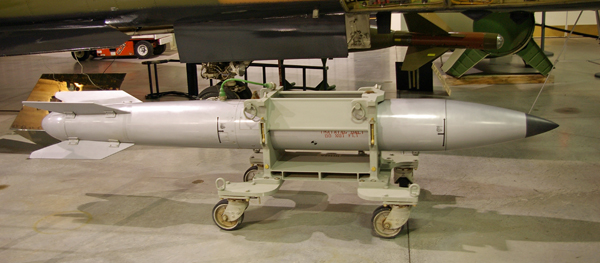This post is also available in:
 עברית (Hebrew)
עברית (Hebrew)
Recently, two German Tornado fighter jets were spotted flying over the United States, specifically near Edwards Air Force Base in California. The jets were carrying B61-12 nuclear bomb trainers, a non-explosive variant used for training purposes. This latest version of the B61 family has selectable explosive yields up to 50 kilotons of TNT, compared to the 15 and 25-kiloton yields of the bombs dropped on Hiroshima and Nagasaki almost 80 years ago.
The sighting, captured on August 27, reveals the German aircraft equipped with the B61-12 trainer under their fuselages, as reported by Newsweek. Hans Kristensen, director of the Nuclear Information Project at the Federation of American Scientists, confirmed the presence of the trainer bomb. The Tornado jets, part of the German Air Force, are among NATO’s certified aircraft capable of carrying both nuclear and non-nuclear weapons. These dual-capable aircraft are integral to NATO’s nuclear sharing arrangements, designed to deliver American nuclear weapons if required.
The B61-12 nuclear bomb trainer does not carry live explosives but is used for training to simulate the presence and operation of real nuclear bombs. This non-explosive version ensures that personnel can practice handling and deploying the weapon without the risk of accidental detonation.
The Tornado IDS, the variant of the Tornado seen in the recent deployment, is known for its high accuracy and versatility in all weather conditions. It can carry a variety of weapons and defensive systems, including two internally mounted guns and AIM-9 Sidewinder missiles. Equipped with advanced terrain-following and electronic counter-measure systems, the Tornado IDS is designed for high survivability.
In NATO’s nuclear deterrence strategy, Germany plays a crucial role. The Tornado jets are currently the designated platform for delivering nuclear weapons under NATO’s framework, although they are expected to be replaced by the F-35 in the near future. This deployment underscores Germany’s ongoing commitment to NATO’s nuclear deterrence capabilities amid rising global tensions.
The B61 nuclear gravity bomb has been in service for over 50 years. Since its introduction in 1968, the bomb has undergone numerous modifications to enhance its safety, security, and reliability. Currently, there are four B61 variants in the arsenal: the 3, 4, 7, and 11. The U.S. is also undertaking a life extension program to ensure the continued effectiveness of the B61 series.


























